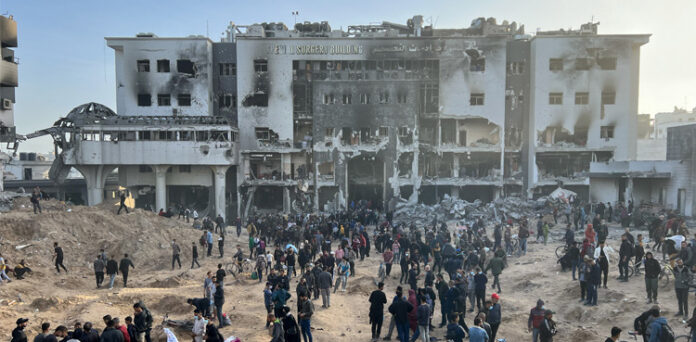UNITED NATIONS: With the largest hospital in Gaza largely destroyed and out of action, access to healthcare has now become “totally inadequate” following six months of Israeli attacks, the World Health Organization (WHO), a Geneva-based UN agency, has said.
That’s the assessment following a WHO-led multi-agency mission to Al-Shifa Hospital in northern Gaza on 5 April which examined the extent of destruction following a weeks-long Israeli offensive aimed at rooting out militant forces who were allegedly operating inside.
The highly complex mission was conducted in collaboration with the acting Hospital Director, the agency said.
Prior to the mission, it said, WHO’s efforts to reach the hospital to evacuate patients and staff and conduct an assessment, were denied, delayed or impeded six times between 25 March and 1 April.
Like the majority of the north, Al-Shifa Hospital “is now an empty shell after the latest siege”, said WHO, with no patients remaining at the facility. “Most of the buildings are extensively damaged or destroyed and the majority of equipment is unusable or reduced to ashes.”
The WHO team said that the scale of devastation has left the facility completely non-functional, further reducing access to life-saving healthcare in Gaza.
“Restoring even minimal functionality in the short term seems implausible and will require substantial efforts to assess and clear the grounds for unexploded ordnance to ensure safety and accessibility”, said WHO.
The hospital’s emergency department, surgical, and maternity ward buildings are extensively damaged due to explosives and fire. At least 115 beds in what once was the emergency department have been burnt and 14 incubators in the NICU destroyed, among other assets.
An in-depth assessment by a team of engineers is needed to determine if these buildings can be made safe for future use. The hospital’s oxygen plant has been destroyed, leaving Kamal Adwan Hospital as the only source of medical oxygen production in the north.
Further comprehensive assessment is essential to evaluate the functionality of vital equipment such as CT scanners, ventilators, sterilization devices, and surgical equip Numerous shallow graves have been dug just outside the emergency department, and the administrative and surgical buildings, WHO said.
“In the same area, many dead bodies were partially buried with their limbs visible. During the visit, WHO staff witnessed at least five bodies lying partially covered on the ground, exposed to the heat” with “a pungent smell of decomposing bodies engulfing the hospital compound.
“Safeguarding dignity, even in death, is an indispensable act of humanity”, the agency added. According to the acting Hospital Director, patients were held in abysmal conditions during the siege. They endured severe lack of food, water, healthcare, hygiene and sanitation, and were forced to relocate between buildings at gunpoint.
At least 20 patients have reportedly died due to the lack of access to care and limited movement authorized for health personnel.
Despite deconfliction, Friday’s mission faced significant delays at the militANN(Asian News Network) checkpoint en route to Al-Shifa Hospital.
